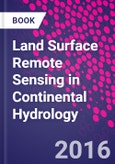The continental hydrological cycle is one of the least understood components of the climate system. The understanding of the different processes involved is important in the fields of hydrology and meteorology. In this volume the main applications for continental hydrology are presented, including the characterization of the states of continental surfaces (water state, snow cover, etc.) using active and passive remote sensing, monitoring the Antarctic ice sheet and land water surface heights using radar altimetry, the characterization of redistributions of water masses using the GRACE mission, the potential of GNSS-R technology in hydrology, and remote sensing data assimilation in hydrological models. This book, part of a set of six volumes, has been produced by scientists who are internationally renowned in their fields. It is addressed to students (engineers, Masters, PhD) , engineers and scientists, specialists in remote sensing applied to hydrology. Through this pedagogical work, the authors contribute to breaking down the barriers that hinder the use of Earth observation data.
Please Note: This is an On Demand product, delivery may take up to 11 working days after payment has been received.
Table of Contents
1. Characterization of Soil Surface Properties Using Radar Remote Sensing 2. Estimation of Soil Water Conditions Using Passive Microwave Remote Sensing 3. Using Satellite Scatterometers to Monitor Continental Surfaces 4. Optical Remote Sensing of Snow Cover 5. Snow Characterization Using Radar Imaging 6. Spatial Altimetry and Continental Waters 7. Radar Altimetry for Monitoring the Antarctic Ice Sheet 8. Monitoring Water Mass Redistributions on Land and Polar Ice Sheets using the GRACE Gravimetry from Space Mission 9. Applications of GNSS-R in Continental Hydrology 10. Energy Balance of Continental Surfaces and the Use of Surface Temperature 11. Remote Sensing Data Assimilation: Applications to Catchment Hydrology 12. Satellite Data Assimilation: Application to the Water and Carbon Cycles








